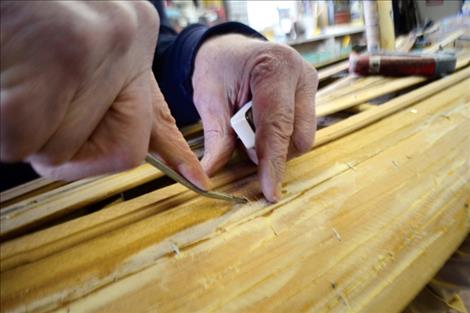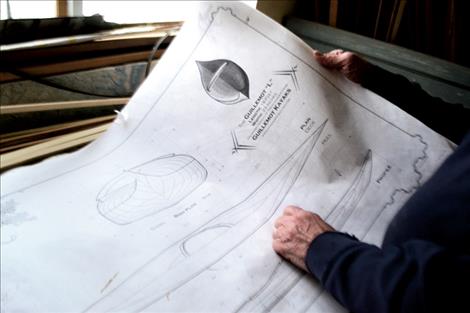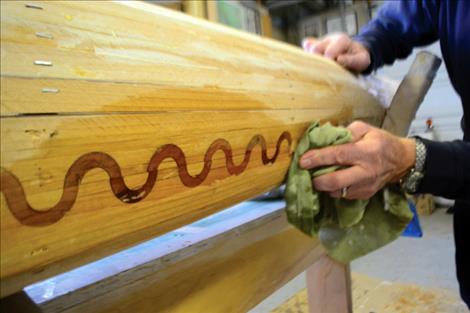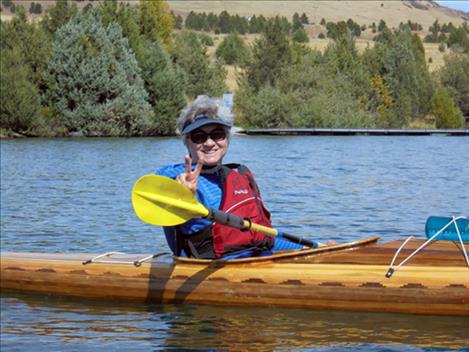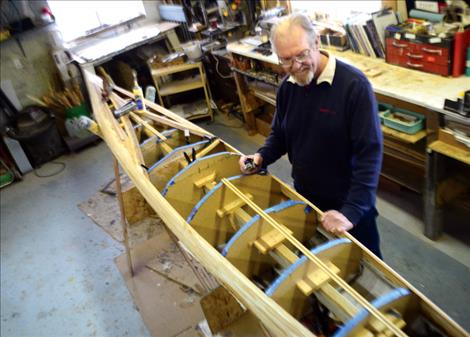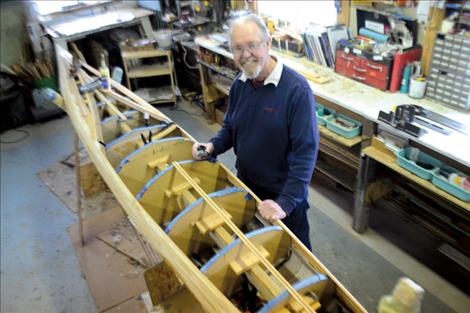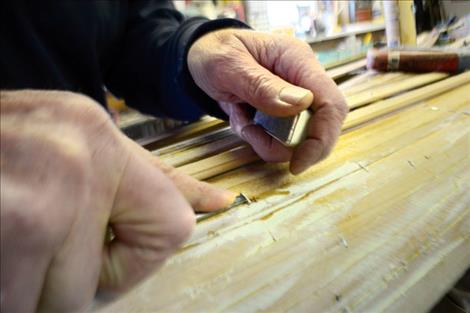Kayaks & community: making both better
Hey savvy news reader! Thanks for choosing local.
You are now reading
3 of 3 free articles.
Outside Gary Teggeman’s shop the stubborn cold refuses to rise above single digits. But there’s no place he’d rather be. Teggeman, who spent his career providing area veterinarians with supplies and medicines, has built a vessel in his home shop each winter since he retired in 2007. “I’m happy and giggling the whole time I’m out there,” he said.
Already familiar with woodworking, Teggeman learned to craft vessels by reading books and chatting with a professional canoe maker in Swan Valley. He’s built four canoes, one stand up paddleboard, and now he’s fashioning his fifth kayak.
His latest finished project, a 17-foot handmade cedar kayak valued at about $3,000, will soon be in the hands of a lucky winner, but the real winner will be the Mission Valley Aquatic Center. Teggeman built the kayak to help the pool with maintenance costs. Teggeman previously donated the paddleboard and two canoes to support Mission Valley Aquatics’ fundraising efforts to build the local pool, which opened in 2013.
The kayaks are primarily constructed from strips of western red cedar. He finds long, clear strips locally from an Amish man in St. Ignatius, and from a dealer in Washington State. Some of his accent strips are ash, which he uses for contrasting patterns. Occasionally he gets dark cedar flooring scraps from Buckeye Hardwoods in Arlee.
Teggeman cuts and mills the ¾-inch cedar strips using two routers — one above the strip and one below — to create a bead side and a cove side, allowing the strips to seat together.
One at a time, the narrow strips are stapled and nailed into place, using a strongback — a type of wooden skeletal form used as a shaping guide for the Guillemot Kayak pattern. The hull, or bottom of the boat, is created separately from the deck, or topside.
Once the hull is built, a fiberglass liner is placed inside. Four coats of epoxy seal and finish the interior. He then connects the hull to the deck with a ribbon of epoxy- soaked fiberglass along the interior seam, a process that requires a flashlight and a long roller stick as he works through the cockpit.
“Sixty percent of the strength comes from the fiberglass,” Teggeman said.
The outside is finished with seven or eight coats of marine-grade epoxy to create a smooth gloss and strengthen the cedar.
His latest project boasts a wave running the length of the kayak, created by meticulously cutting small pieces of arched wood in a contrasting pattern.
The 17-foot, 55-pound kayaks include a lip in the cockpit that fits a skirt, and a watertight storage area that can hold light camping equipment. “They are pretty lightweight and easy enough to get on a car top,” he said.
The slim and sleek design is fast and cuts through water like a “hot knife through butter,” he said, with no need for a rudder. “They ride Flathead Lake so well.”
Gary and Nancy Teggeman spend much of their summer and fall kayaking on Flathead Lake in their homemade vessels. Nancy, a retired schoolteacher, said they have launched at 12 locations around the lake, and each one offers a different view. Nancy’s kayak has two dolphin insets, a reminder of her days working at Sea World in San Diego as a young lady.
Gary Teggeman’s current kayak will be finished in “March, or April, or May,” he said. “I don’t have a home for it yet.”
Teggeman doesn’t like to sell his vessels, but prefers to donate his labor and the $400 to $500 cost of materials to a local non-profit to help fund the organization.
“I’d just a soon give it to an organization to make some money,” Teggeman said.
The donated kayak currently on display at Mission Valley Aquatic Center will have the winning ticket drawn Feb. 26. Tickets can be purchased at the pool for $10 each or three for $25.
“It’s one of my most intensive designs,” he said, explaining that the contrasting woods create a sort of tribal pattern.
Is it his favorite?
“The newest one is always my favorite,” he said.















